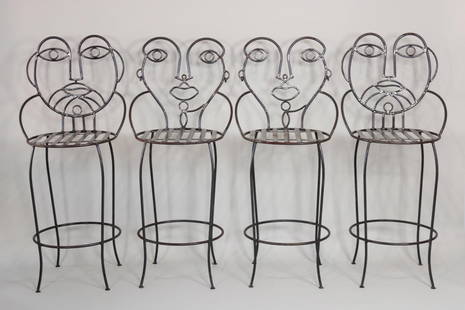
An Archaic Hagabi
Similar Sale History
View More Items in Benches & StoolsMore Items in Benches & Stools
View MoreRecommended Furniture
View More


Item Details
Description
An Archaic Hagabi
Kiangan, Ifugao19th century
narra wood with native repair
length: 4 meters/13 feet 2 inchesheight from floor to highest peak of the centerbench: 19" (48 cm)width of bench at widest point: 48 cm
PROVENANCEWilliam BeyerRamon TapalesAngel Lontok Cruz
LITERATUREQuintos, Floy. Provenance: Ramon Tapales (Collections andRecollections). Kaurava Publishing. Quezon City. 2014. Page 10.
The word “Archaic” when used in international Tribal Art circles, refers to objects made by Indigenous peoples before significant contact with the West or with foreign colonizers. The word can also describe an object of great age that contains or reflects the “purest” aesthetics of a people. Aesthetics undiluted by outside influences that, when mixed with traditional sensibilities, produce, what Western tribal art dealers often condescendingly call, “degenerate” art. This Hagabi is a magnificent example of an archaic piece. In a previous catalogue entry for the (now famous) Lopez hagabi, I described the ritual significance of the Ifugao prestige bench, the circumstances under which it is commissioned, as well as the process by which the proper Narra tree (sacred to the Ifugao for its blood red sap) is selected and felled and carved with only metal adzes and machetes. In that entry, I also wrote about how the Hagabi was a reflection, not only of the owner’s status, but also his social obligations to feed the community during times of famine and poor harvest. This piece reflects the highest aesthetics of traditional Ifugao society, combining both functional knowledge as well a simplified, practical design. The two extended zoomorphic heads (the smaller, denoted as “Female”, the larger, stouter one signifying the “Male”) serve to balance and anchor the bench to the ground. The raised ears of the animal serve as the backrest on which the owner would lounge after a day of hard work at the fields, his or her feet, raised up. Thus seated, the whole body would then be relaxed. When viewed from the side, the lounging portion is a delicate, gently peaking plank, a visual counterpoint to the powerfully rendered zoomorphic heads. The entire piece embodies traditional Ifugao design and sense of proportion, now burnished by the wear of traditional usage. Old, native repair shows that the two heads had once been cut off and then reattached, most probably when the piece was brought down from Ifugao to Manila in the early 1970s. This brings us to the most interesting part of the Hagabi’s history: Its provenance, which can be traced to three men who shaped the tastes and aspirations of future generation of Filipino Tribal Art collectors. The piece was first owned by the collector/dealer William Beyer. Bill, as he was more fondly known, was the son of the American archeologist and anthropologist Henry Otley Beyer, renowned as the Father of Philippine Archeology. William’s mother was Ling-ngayu Gambuk, an Ifugao woman from Amganad. Having grown up in Ifugao with so illustrious a father, William was in a unique position to acquire many original objects from Ifugao families. This he did from the 1960s to the 1980s, thus contributing to his reputation as the most renowned Tribal art dealer of his time. He first lent this Hagabi to the National Museum in the early 1970s. Eventually, Beyer sold it to the collector Ramon Tapales, his long -time friend and client. Tapales was known in the International tribal art circles for his fine eye and discerning taste. Tapales was the source of many important objects now in international collections. In fact, many of these were showcased in the important 2013 show, “Philippines: An Archipelago of Exchange” at the Musee du’Quai Branly in Paris. In his memoir, “Provenance: Collections and Recollections”, there is a photo of Tapales dating from the 1970s, showing him reclining on this Hagabi. “At that time,” remembers Tapales, “Bill claimed that this was the longest Hagabi he had ever bought in situ.” The piece was later sold by Tapales to his colleague, Angel Lontok Cruz. Both men were “friendly competitors” who were most active from the 1970s to the 1990s. In hindsight, it was a dual-faced period. For while great political, financial, cultural and religious upheavals were sweeping through Philippine traditional communities and changing these forever, it was also a rich harvest season for collectors of both Philippine Tribal as well as Colonial art. While many of Tapales’ prized possessions were dispersed among European and American collectors in the late 90s, the Angel Lontok Cruz collection of Ifugao art remains intact in Europe. Because of its sheer size, only this Hagabi has remained in the Philippines. Thus, this archaic Hagabi is both Artifact and Record. As an object, it embodies the highest standards of Ifugao traditional society. It is also a record of three men who first discovered the beauty of Ifugao art and made it their life-long passion. Sadly, this impressive provenance will never be complete because William Beyer’s acquisition notes have been lost. Thus, we will never know the name of the first owner, the noble Kadangyan who first commissioned this masterpiece.
Buyer's Premium
- 22%
An Archaic Hagabi
Estimate ₱2,000,000 - ₱2,600,000
2 bidders are watching this item.
Shipping & Pickup Options
Item located in Makati City, Metro Manila, phSee Policy for Shipping
Payment

Related Searches
TOP



















































